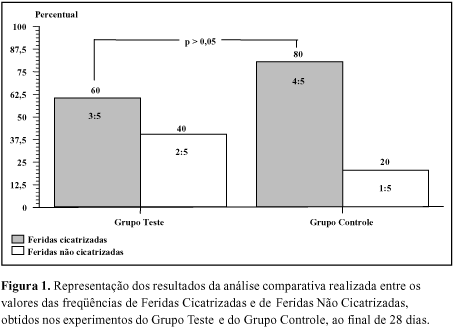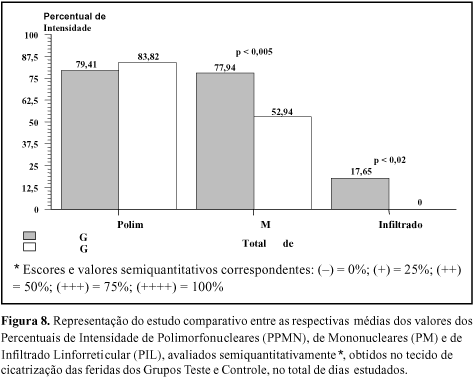Objective: To study the effect of frog skin as occlusive dressing on cutaneous wounds. Methods: Fifteen mongrel dogs, of both sexes, weighing 9.45 ± 2.62 kg, under general anesthesia, were submitted to 34 square shaped skin lesions, with 400 mm² of area, on both right and left thoracodorsal surfaces. After defrosting, Rana catesbeiana skins preserved in a ClNa and glycerol solution at --4ºC were used as biological occlusive dressing on 17 lesion located in the right thoracodorsal region (Test Group). The 17 lesions on the left thoracodorsal side were treated with gauze moistened in a 0.9% ClNa solution (Control Group). The frequency of healed (HW) and non-healed wounds (NHW), and the incidence of frog skin destruction, were analyzed. Five sequences of frog skin samples were histologically examined till tissue destruction started to appear. Inflammatory histological findings were evaluated by percentage of intensity of Polymorphonuclear cells (PPMNC), Mononuclear cells (PMC), and lymphoreticular infiltration (PLI). Two tailed Student's t test and chi square test (chi²) were used as indicated. Results: 1) There was no significant difference in HW and NHW between Groups; 2) There was a 31.00% incidence of frog skin destruction limited to the surface in contact with dog wounds. An increased tendency of destruction was perceived during the studied period; 3) Histological changes of frog skin, characterized by tissue infiltration mainly from mononuclear cells, and by destruction of Malpighi and subjacent layers, were observed at the surface, limited to the wound contact area; 4) PPMNC values attained were not statistically different between groups. In the Test Group PM prevailed and PLI was exclusively seen. Conclusion: Frog skin is ineffective in treatment of canine cutaneous wounds and rejection was suggested as a causative factor.
Biological dressings; Skin; Wound healing; Dogs









